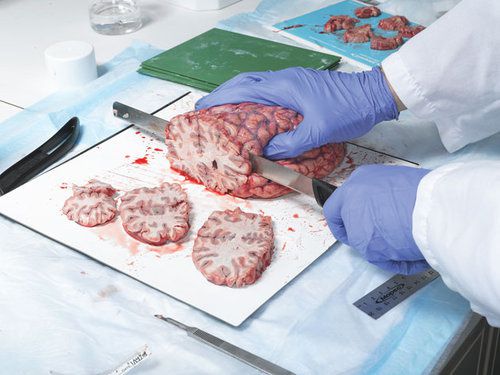Dissection Begins on Famous Brain

SAN DIEGO — The man who could not remember has left scientists a gift that will provide insights for generations to come: his brain, now being dissected and digitally mapped in exquisite detail.
The man, Henry Molaison — known during his lifetime only as H.M., to protect his privacy — lost the ability to form new memories after a brain operation in 1953, and over the next half century he became the most studied patient in brain science.

He consented years ago to donate his brain for study, and last February Dr. Jacopo Annese, an assistant professor of radiology at the University of California, San Diego, traveled across the country and flew back with the brain seated next to him on Jet Blue.
Just after noon on Wednesday, on the first anniversary of Mr. Molaison’s death at 82 from pulmonary complications, Dr. Annese and fellow neuroscientists began painstakingly slicing their field’s most famous organ. The two-day process will produce about 2,500 tissue samples for analysis.
A computer recording each sample will produce a searchable Google Earth-like map of the brain with which scientists expect to clarify the mystery of how and where memories are created — and how they are retrieved.
“Ah ha ha!” Dr. Annese said, as he watched a computer-guided blade scrape the first shaving of gray matter from Mr. Molaison’s frozen brain. “One down, 2,499 more to go.”
Dr. Annese carefully dropped the shaving into fluid. The procedure is being shown live online: thebrainobservatory.ucsd.edu/hm_live.php.
“It’s just amazing that this one patient — this one person — would contribute so much historically to the early study of memory,” said Dr. Susumu Tonegawa, a professor of neuroscience at the Picower Institute for Learning and Memory at M.I.T. “And now his brain will be available” for future study.
Good fortune and very bad luck conspired to make Mr. Molaison one of science’s most valuable resources and most productive collaborators. Growing up in and around Hartford, he began to suffer seizures as a boy. The seizures grew worse after he was knocked to the ground by a bicycle rider, and by the time he was 26 they were so severe he consented to an experimental brain operation to relieve them.
His doctor, the prominent brain surgeon William Beecher Scoville, suctioned out two slug-sized slivers of tissue, one from each side of the brain. The operation controlled the seizures, but it soon became clear that the patient could not form new memories.
“He loved to converse, for example, but within 15 minutes he would tell you the same story three times, with same words and intonation, without remembering that he’d just told it,” said Suzanne Corkin, a neuroscientist at the Massachusetts Institute of Technology who studied and followed Mr. Molaison in the last five decades of his life.
Each time he met a new acquaintance, each time he visited the corner store, each time he strolled around the block, it was as if for the first time.
Before H.M., scientists thought that memory was widely distributed throughout the brain, not dependent on any one area. But by testing Mr. Molaison, researchers in Montreal and Hartford soon established that the areas that were removed — in the medial temporal lobe, about an inch deep in the brain level with the ear — are critical to forming new memories. One organ, the hippocampus, is especially crucial and is now the object of intense study.
In a series of studies, Mr. Molaison soon altered forever the understanding of learning by demonstrating that a part of his memory was fully intact. A 1962 paper by Dr. Brenda Milner of the Montreal Neurological Institute described a landmark study in which she had Mr. Molaison try to trace a line between two five-point stars, one inside the other.
Each time he tried the experiment, it seemed to him an entirely new experience. Yet he gradually became more proficient — showing that there are at least two systems in the brain for memory, one for events and facts and another for implicit or motor learning, for things like playing a guitar or riding a bicycle.
In the new brain-mapping project here, set to catalog many donated brains, scientists will have the ability to study areas of Mr. Molaison’s brain at a level of detail that imaging cannot reveal, to solve lingering mysteries about the man and the brain.
Mr. Molaison stunned researchers several times, for instance, by demonstrating that he could hold onto some new memories. He could reproduce exactly the floor map of his house on Crescent Drive in East Hartford, where he lived for years after his operation with his parents.
These and other scattered surprises suggest that Mr. Molaison’s brain, deprived of its central memory hub, recruited other nearby areas to try to compensate, scientists say. Now researchers can begin to study these poorly understood areas more closely. One region, called the parahippocampal cortex, appears to support “familiarity” memory, the sensation that we have seen or heard something before, though we cannot place it.
“We’ve learned a lot about memory, we’re getting close to the fire, and H.M.’s brain will really help us clarify the division of labor in this area for making memories,” said Dr. Lila Davachi, a neuroscientist at New York University.
The dissection, a novel whole-brain technique, is part of a project known as the Brain Observatory and the culmination of a year of frantic preparation. Dr. Corkin arranged for Mr. Molaison’s brain to be preserved and imaged; up until Sunday the laboratory was tweaking its equipment, buying surfboard leashes at the last minute to support some of its freezing hoses.
“W e hope that this project as it grows will catalyze cooperation across many disciplines” to study disorders like amnesia, tremors, and dementias, Dr. Annese said. “But we wanted to kick it off with the most famous brain of them all.”
source: http://www.nytimes.com/2009/12/03/health/research/03brain.html?_r=1&ref=science
